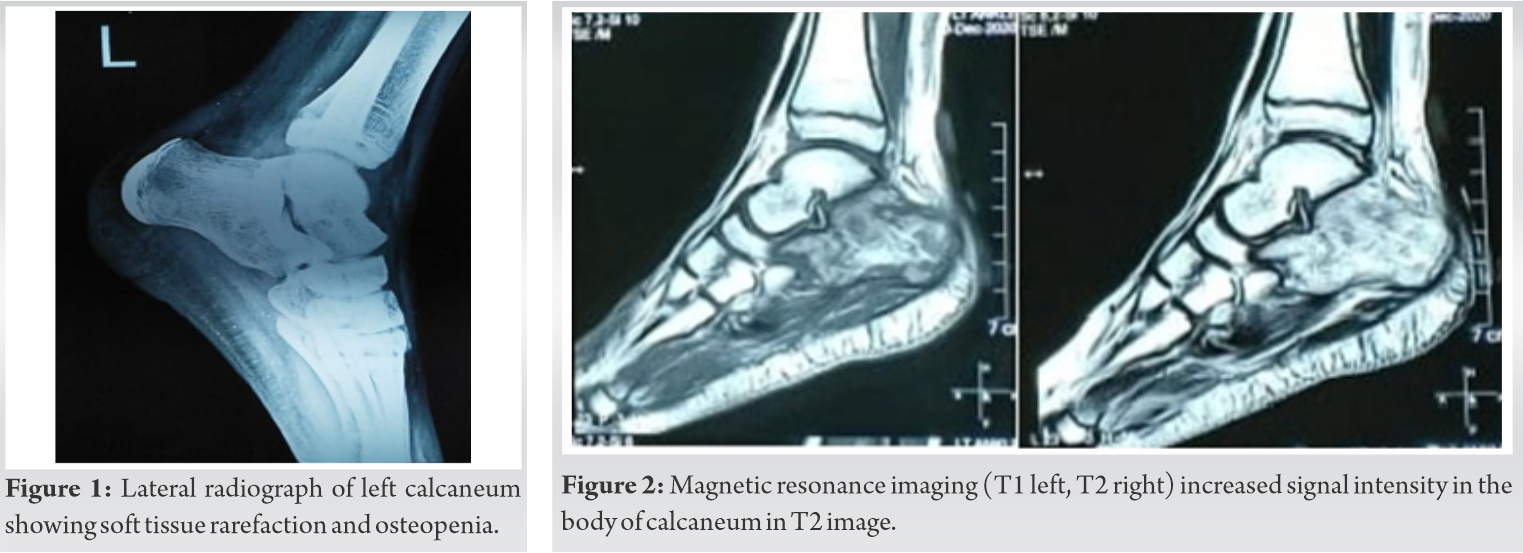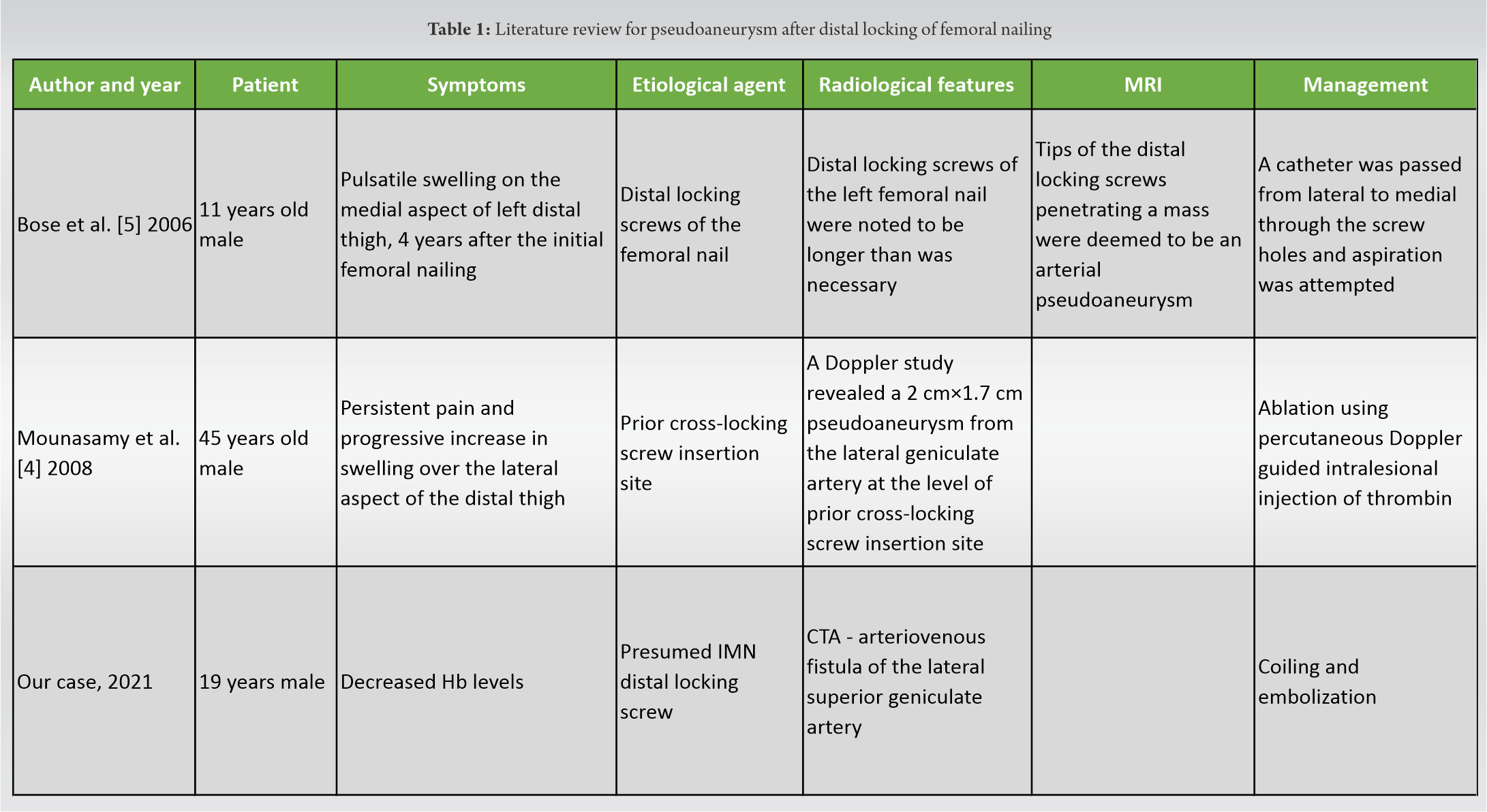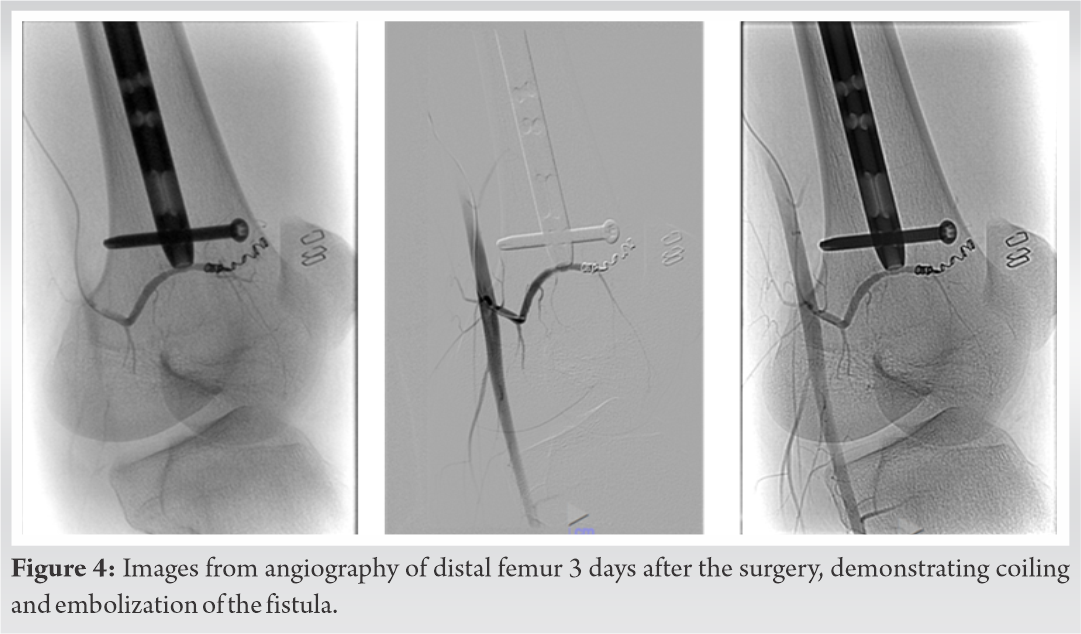Surgical technique, and strict post-operative follow-up, may allow early diagnosis unnecessary essential for treatment.
Dr. Mahmoud Jammal, Department of Orthopaedic, Hadassah Medical Centres, Hebrew University, Kiryat Hadassah, P.O.B: 12000, Jerusalem 91120, Israel. E-mail: jammalm@hadassah.org.il
Introduction:An arterial pseudo aneurysm formation is an unusual complication following intramedullary nail distal locking screw insertion. During such surgical procedure, arterial laceration might damage the wall, allowing blood leakage into the soft- tissue surrounding. Only few records are available regarding such injuries.
Case Report: A 19-year-old male diagnosed with femoral shaft fracture after a trauma event, was treated using Antegrade Long Intra-Medullary Nail with distal locking screw. Following post-operative serial blood count indicating a consistent decrease in his Haemoglobin levels, a Computed Tomography angiogram was performed and showed an arteriovenous fistula of the lateral superior geniculate artery. The artery was coiled, and haemoglobin levels were stabilized again.
Conclusion: A distal interlocking screw should be carefully placed, including blunt dissection before the drilling and screw placement. In addition, blood counts were proved essential in routine.
Keywords: Arteriovenous fistula, intramedullary nail distal locking, antegrade long intra-medullary nail.
Arterial pseudoaneurysm formation is a rare consequence of orthopedic surgery. A pseudoaneurysm occurs when a blood vessel wall is breached, and the blood leaking through it is contained by hematoma, perivascular soft tissue, and the adventitia surroundings [1]. Clinically, such injury does not present with common signs of ischemia, and therefore may be overlooked. Pseudoaneurysms might result from Total Knee Arthroplasties (TKA), but may also follow other knee surgeries in the popliteal artery, such as superolateral, inferolateral, or inferomedial geniculate arteries [2].
Diaphyseal femoral fractures are common, and in adults often treated with interlocked intramedullary nailing. Vascular injuries, however, are uncommon and usually occur when the drill bit or screws have over penetrated – particularly during the distal interlocking procedure [3].
A 19-year-old male, normally healthy and with no medical issues, arrived to the emergency room (ER) after being involved in a motor vehicle accident. He was presented with multiple injuries including swelling, deformity with tenderness of middle thigh, sensation, and distal pulse intact. In the ER, the patient was stable with 16.1 hemoglobin (Hb). A diagnosis of diaphyseal femoral fracture was determined, and a splint was applied.
Under anesthesia, the patient underwent Closed Reduction with Internal Fixation using Antegrade Long Intra-Medullary Nail (IMN) with distal locking screw (Fig. 1 and 2). The screw was placed from lateral to medial after a stab-wound skin cut, using a mosquito for blunt dissection before drilling. Postoperatively, the patient felt well, was stable with normal blood pressure and had no tachycardia. Blood was collected during 3 days post-operation and the Hb levels were: 11.8, 8.7, and 6.8. After blood transfusion, Hb levels were improved.
The screw was placed from lateral to medial after a stab-wound skin cut, using a mosquito for blunt dissection before drilling. Postoperatively, the patient felt well, was stable with normal blood pressure and had no tachycardia. Blood was collected during 3 days post-operation and the Hb levels were: 11.8, 8.7, and 6.8. After blood transfusion, Hb levels were improved.
A computed tomography angiography was performed, presenting an arteriovenous fistula of the lateral superior geniculate artery (Fig. 3). The artery was closed with a coil (Fig. 4) and Hb levels were recovered once more (Table 1).
Vascular injury after IMN distal interlocking, is rare and has scarce evidence in the literature. As a possible cause for this complication, Yang et al. suggested that the involved limb adducted and internally rotated, which may cause abutment of the femoral vessels to the femur, endangering the superficial femoral artery. Therefore, they suggested that during preparation of the interlocking hole, the limb will be placed in a neutral position [2].
Mounasamy et al. (Table 1) reported a pseudoaneurysm case of lateral geniculate artery at the distal screw insertion site of interlocked IMN, diagnosed after Doppler examination was done to exclude a recurrent abscess associated with the trauma a year before [4].
In a case reported by Bose et al. (Table 1), 4 years post the initial femoral nailing; a pulsatile swelling was noticed on the medial aspect of the left distal thigh. US and MRI showed a penetration of the distal locking screws tips to the mass, which was suspected to be an arterial pseudoaneurysm [5].
In most reported cases of post-TKA, pseudoaneurysms were also described. Pai et al. reported a false aneurysm of the inferior lateral geniculate artery, following a total knee replacement as a pulsatile mass with compressive neuropathy of the posterior tibia nerve [6]. Dennis et al. described a traumatic arteriovenous fistula with false aneurysm as a TKA complication [7]. Langkamer et al. presented a case report in which an A-V fistula was confirmed 6 weeks after TKA [8]. Another case of pseudoaneurysm, 3 weeks after anterior cruciate ligament repair, was presented by Oversier et al. [9]. Scoles et al. described a patient with hemophilic arthroplasty following synovectomy. In this case, the descending genicular artery evolved as a complication of suction drainage from a knee [10].
However, most reported cases of distal locking related lateral geniculate artery pseudoaneurysm, are delayed post-operative complications. The injury case presented here differs in timing, with immediate post-operative acute bleeding up to dangerously decreasing hemoglobin levels.
Our case report joins to rare evidences of pseudoaneurysm related to distal IMN interlocking. We conclude that distal interlocking screws should be carefully placed, including blunt dissection before drilling and screw placement. In addition, post-operative physical examination as well as blood count, should be performed as part of the routine.
Although hemoglobin level frequently decreases post-operation, if continuing, it might indicate a rare arteriovenous fistula as was described here. This case proves the importance of blunt dissection before drilling, as well as post-operative serial blood count as follow-up.
References
- 1.Green DP. True and false traumatic aneurysms in the hand. J Bone Joint Surg Am 1973;55:120-8. [Google Scholar]
- 2.Shaw A, Stephen A, Lund J, Bungay P, Denunzio M. Geniculate arterial pseudoaneurysm formation following trauma and elective orthopaedic surgery to the knee: 2 Case reports and a review of the literature. J Radiol Case Rep 2009;3:12-6. [Google Scholar]
- 3.Yang KH, Park HW, Park J. Pseudoaneurysm of the superficial femoral artery after closed hip nailing with a Gamma nail: Report of a case. J Orthop Trauma 2002;16:124-7. [Google Scholar]
- 4.Mounasamy V, Dolbeare D, Willis M. Pseudoaneurysm of the lateral geniculate artery at the distal interlocking screw site. Eur J Orthop Surg Traumatol 2008;19:197-201. [Google Scholar]
- 5.Bose D, HauptXeisch J, McNally M. Delayed pseudoaneurysm caused by distal locking screw of a femoral intra medullary nail: A case report. J Orthop Trauma 2006;20:584-6. [Google Scholar]
- 6.Pai VS. Traumatic aneurysm of the inferior lateral geniculate artery after total knee replacement. J Arthroplasty 1999;14:633-4. [Google Scholar]
- 7.Dennis DA, Neumann RD, Toma P, Rosenberg G, Mallory TH. Arteriovenous fistula with false aneurysm of the inferior medial geniculate artery. A complication of total knee arthroplasty. Clin Orthop Relat Res 1987;222:255-60. [Google Scholar]
- 8.Langkamer VG. Local vascular complications after knee replacement: A review with illustrative case reports. Knee 2001;8:259-64. [Google Scholar]
- 9.Oversier LM, Corten BJ, Barten DG, Elshof JW. Pseudoaneurysm of the superior lateral genicular artery following anterior cruciate ligament repair. Acta Chir Belg 2017;118:258-63. [Google Scholar]
- 10.Scoles PV, King D. Traumatic aneurysm of the descending geniculate artery: A complication of suction drainage in synovectomy for hemophilic arthropathy. Clin Orthop Relat Res 1980;150:245-6. [Google Scholar]









